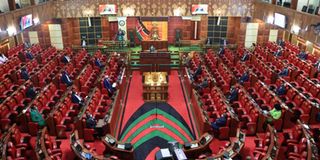Activate gender rule within our first-past-the-post system

The National Assembly during a past session.
What you need to know:
- Historically, this has disadvantaged women candidates.
- To remedy this, the Constitution created the Woman Rep position to increase the representation of women in Parliament.
The National Assembly has 349 seats — 290 elected in single-member constituencies; 47 elected woman representatives per county (single-member constituencies) and 12 party-nominated.
The elective seats are awarded through the first-past-the-post system; the candidate with the most votes stands elected. Historically, this has disadvantaged women candidates and, to remedy this, the Constitution created the Woman Rep position to increase the representation of women in Parliament. In addition, it required Parliament to pass laws to ensure it shall not have more than two-thirds members of one gender.
With the fixed number, we need at least 116 women MPs to comply with the gender rule. But the National Assembly has 274 men and 75 women. How, then, do we meet this requirement within our current system? Well, I propose that we fill this gap by turning counties into multi-member constituencies that would provide the extra members.
Computation
The process would first entail computing the size of a House that meets the requirement using the number of members of the same gender with the majority. If, for instance, 274 men are two-thirds of MPs, what would the size of that House be? (274/2) x 3 = 411 (rounded up). This house would need at least 137 women. But we already have 75 women MPs; so we need an additional 62. But where from?
These seats would be distributed across counties while using the population figures of the last census as a determinant. Highly populated counties would get a larger share of the additional MPs. Therefore, Nairobi, with its 4,397,073 people, that is nine per cent of the population, would get nine per cent of the additional seats. Nairobi would have six seats, Nakuru three, Kwale one, and so on.
In a worst-case scenario, where only the 47 woman reps get elected, then the National Assembly would need to balloon to 453 MPs; that would require an additional 104 women. Nairobi would have to submit 10 women, Kakamega four, and so on. On the flip side, if Kenyans managed to get 110 women MPs, then the House would only need 10 more seats.
The extra seats would be awarded to the top women candidates who unsuccessfully vied for the constituency seats in the county, ranked in order of votes acquired. If she is not interested or available, the one next in line would take it. There would be no by-elections to fill these seats if they fell vacant as the candidate next in line would be appointed.
The next complaint will predictably be, “But we are already burdened by the 349 MPs; we cannot afford more.” The financial burden can be generally thought of as a product of two variables: Number of MPs and cost per MP. And since we overpay our MPs, reducing their salaries is the low-hanging fruit to pick to have affordable representative democracy.
Mr Ngumi is an election technology adviser. [email protected].




